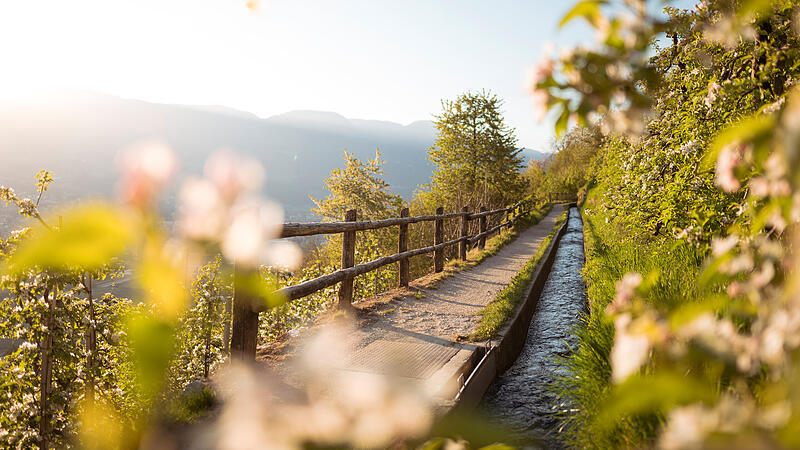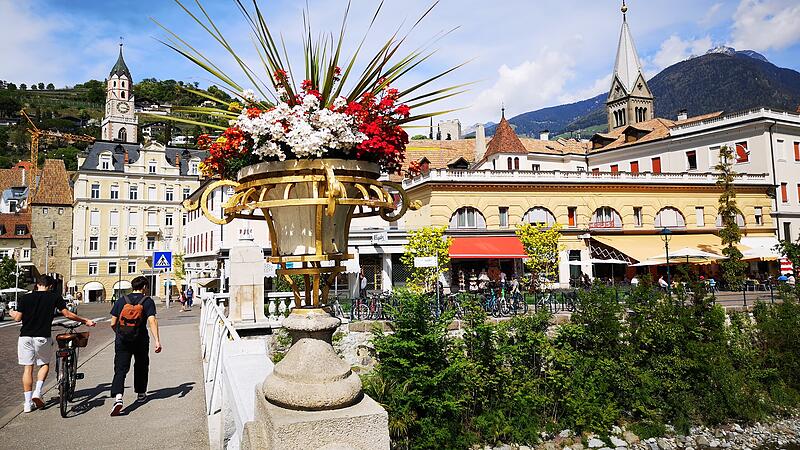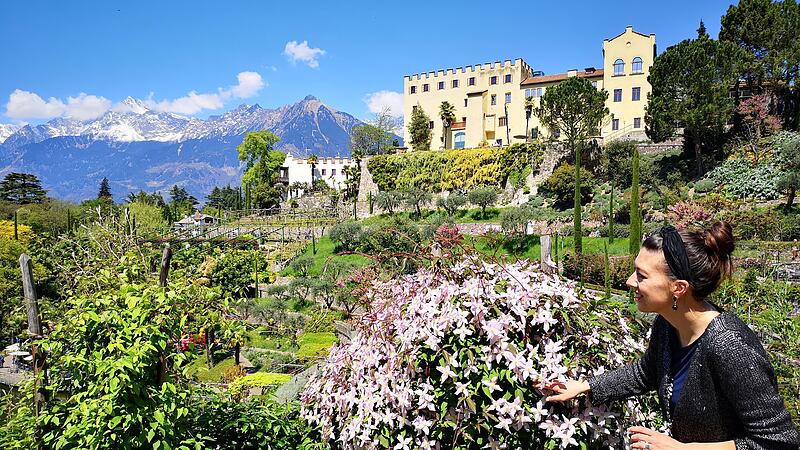Radiant white, soft pink – they can just be seen, the cute or lush blossoms on the branches of the apple trees, depending on the variety. Rooted in rank and file, they cover the valley floor around the Etsch with a delicate pattern. They are also present on the slopes and repeatedly form a trellis for hikers on the Marlinger Waalweg. Waale are as much a part of South Tyrol as the drought that the farmers have been pining over for what feels like an eternity. The canals are used for irrigation and carry the precious water over long distances. The Marlinger Waal was created between 1737 and 1756 and connects Töll with Schnalls. With its twelve kilometers it is the longest Waal in South Tyrol.


In the flat path, which accompanies the water rippling in a narrow stone bed, you branch off, for example, right at the La Maiena Meran Resort via a short, steep path. Apple groves alternate with sweet chestnuts, cherry trees, beeches and flowering shrubs. On the way you come across small refreshment stations with canisters framed in wood and a cash register into which anyone who wants to quench their thirst with homemade elderberry or apple juice throws a euro. Or you can make a culinary stop at “Schönblick” for a creamy risotto with fresh asparagus or South Tyrolean ravioli with butter and parmesan. The inn, which has existed since 1960, bears its name with good reason. From the terrace you have a view of the valley basin, which is framed by the Texel Group with its three-thousanders and the Sarntal Alps. In it, Meran spreads out along the Passer, which line wide promenades – as befits a spa town.


life-prolonging climate
The former capital of Tyrol became that in the 19th century after the ailing Viennese Princess Mathilde von Schwarzenberg stayed here for several weeks in 1836 with her personal physician Johann Nepomuk Huber. In a booklet, he praised the high quality of air, water and milk, which means that the “natural end of life here can be postponed for a long time”.
It wasn’t long before the well-to-do and nobles heeded the call of the soothing air. In 1870 Empress Elisabeth arrived with her frail favorite daughter Marie Valerie, whose health immediately recovered, which was attributed to the mild climate. “Mia gave her something smart to eat, bacon and dumplings,” is Claudia Gilli’s healing variant, which she announces with a wink. The city guide, who is as humorous as she is lively, describes the development of Merano during this time: “The cow town became a spa town, catapulting it from the Middle Ages into modern times.”
Exotic Giants
Over the Steinernen Steg, under which canoeists paddle between rocks in the wild water of the Passer, you follow the Sissi-Weg – past castle towers, villas and forts. Mighty redwoods, Atlas pines and Himalayan cedars grow in private gardens and small parks, and in some places palm trees grow almost like weeds. The exotics were introduced in the mid-19th century under Mayor Franz Putz to please guests. Today there are 33,000 trees whose trunks measure more than ten meters. If someone doesn’t tip over voluntarily, the people get angry, Claudia Gilli knows: “Chopping down a tree in Merano is worse than murder.”
At the end of the Sissi Trail, Trauttmansdorff Castle is a source of astonishment. Since the mid-1990s, the winter residence of the Austrian Empress in 1870 and 1889 has surrounded 80 gardens with around 8,000 different plants from all over the world on an area the size of around 17 football pitches. A seven-kilometre-long network of paths, which overcomes a hundred meters of altitude in wide loops, leads from the Garden for Lovers through the miniature forests of East Asia and North America, past succulents, over sunny terraces, through an English garden in the style of Gertrude Jekyll, to a water lily pond surrounded by palm trees , camellias and azaleas. Where winter barley is currently acting as a placeholder, 12,000 sunflowers will soon stretch out towards the light. After a classic one-and-a-half hour tour, you ask yourself: What doesn’t thrive here? 35 gardeners take care of the botanical paradise, which intoxicates the senses and where you can comfortably endure half a day strolling and slowing down.


In Meran, passers-by rush through the 400-metre-long Laubengasse with its bay windows and archways. In the shops behind it, where colonial goods were once traded and crafts were practiced, globalization with its well-known chains has long since moved in. The town hall stands out as a relic of fascist architecture. Those who deviate from the busy streets lose themselves in the quiet Steinach district, the oldest part of Merano, stroll through the Bozner Gate from the 14th century, find Art Nouveau buildings such as the Kurhaus or the Stadttheater, explore the Princely Castle, discover the historic “Rössl Bianco” inn ” Old building techniques, a Gothic room and the visible entablature above the inner courtyard. In the new city vinotheque, in whose old vaulted cellar 10,000 bottles of sparkling wine mature, you can taste fine wines from the Meran Winery in a modern ambience.
As a guest in the 5-star gourmet hotel La Maiena Meran Resort in Marlengo, you feel like you are on a balcony overlooking the city, whose charming center can be reached by bus or local train in less than 20 minutes. The feel-good residence run by the Waldner family impresses with a fine wellness oasis with several saunas and the largest nude pool in South Tyrol, which comes just in time to cool down after a Schlager infusion with Andreas Gabalier and Helene Fischer, a 26 meter long infinity outdoor pool (32 degrees ) with an indoor connection, a roof terrace with a jacuzzi, a spacious fitness facility with a view and offers for sporty active holidays. The multi-course culinary creations by gourmet chef Matthias Wenin, who combines, for example, presa from Duroc pork with black salsify and passion fruit, or refines a barley risotto with wild garlic and braised deer cheeks, will enthuse you. Who doesn’t come back?
Info: merano-suedtirol.it lamaiena.it trauttmansdorff.it
Source: Nachrichten




